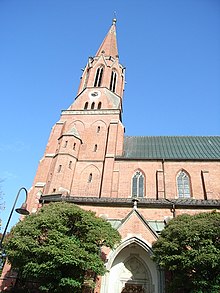City parish church St. Nikolaus (Zwiesel)
The Catholic parish church of St. Nikolaus in Zwiesel is a neo-Gothic , brick- built three-nave church with a transept and a tower.
history
After the old parish church was destroyed in the town fire in 1876, a wooden emergency church was built on May 14, 1877 and consecrated on December 4, 1877. In order to raise the enormous funds for the new building, among other things, a "church building money lottery" was launched, in which 150,000 tickets were sold for two marks, which alone brought in 200,000 marks. Construction began on May 16, 1892 with the ceremonial laying of the foundation stone. The first service was celebrated on October 30, 1896, and the church was consecrated on August 10, 1898 by the Passau bishop Michael von Rampf .
features
Its striking 86 m high church tower made of brick is particularly striking, making it the highest church tower in the Diocese of Passau and one of the highest church towers in Bavaria . The high-vaulted three-aisled basilica made of raw brick masonry with nave and transept and the west tower in front is impressive and has an effect due to its enormous spatial scope. It was designed by the Munich architect Johann Baptist Schott in the medieval high Gothic style, with two lower aisles and a high nave and a transept. During the total renovation from 1983 to 1987, the entire neo-Gothic interior was given a new color scheme, which enhances the spatial impression and thus fully unfolds the architectural and artistic quality of the entire church. The central center of the church is the modern middle altar and the ambo made of clay pottery, which stands on an island in the central center of the church, where the main and transepts meet. It was created by the artist Horst Fochler from Ihrlerstein near Kelheim .
Dimensions
- Length: 70 meters
- Width: 23 meters
- Height: 20 meters
- Tower: approx. 83 meters
Cathedral of the Bavarian Forest
When the Passau bishop Michael von Rampf consecrated the church on August 10, 1898 , he is said to have exclaimed when moving in: "This is not a parish church, this is a cathedral". Not only because of this saying, but also because of its powerful impression, the church is called the "Cathedral of the Bavarian Forest".
Furnishing
The church furnishings of the parish church include the neo-Gothic high altar , the side altars, the pulpit , the Stations of the Cross and the entire choir stalls. Also noteworthy are the life-size statue of the Shackled Savior, a work of the Augsburg sculptor Ehrgott Bernhard Bendl from 1730 in the left side chapel, and the Pietà , which an unknown master from the Mondsee region created around 1550, in the right side chapel. The remaining interior of the church is also preserved in the neo-Gothic style.
The church has high quality stained glass that was financed by various foundations between 1894 and 1913. These are glass pictures from the Munich direction , which worked with large-scale painted glass instead of glass mosaics.
organ
The church has a three-manual organ with 48 registers . An Italian Rückpositiv , a French swell and a major work with a Spanish trumpet make it possible to interpret almost any literature in the proper style. The instrument was built in 1979 by the Passau organ building company Eisenbarth , although initially only two manuals were playable for financial reasons . After the complete renovation of the parish church, the third manual (Rückpositiv) was expanded and the other manuals were supplemented by additional registers. Since then, well-known organists from all over the world (including Odile Pierre , Guy Bovet and Jane Parker-Smith ) have performed on this instrument at the "Zwieseler Orgelage" and paid the organ the highest praise. After the financial support from the city of Zwiesel ceased, the "Zwieseler Orgelage" was discontinued in 2005.
|
|
|
|
||||||||||||||||||||||||||||||||||||||||||||||||||||||||||||||||||||||||||||||||||||||||||||||||||||||||||||||||||||||||||||||||||||||||||||||||||||||||||||||||||||
- Coupling: I / II, III / I, III / II, I / P, II / P, III / P,
- Playing aids : free combinations , tutti, shelves, register crescendo
literature
- Peter Morsbach, Wilkin Spitta: City churches in Lower Bavaria. Regensburg 2003.
Web links
Individual evidence
- ↑ More information on the Eisenbarth organ
Coordinates: 49 ° 0 ′ 55 ″ N , 13 ° 14 ′ 1 ″ E




